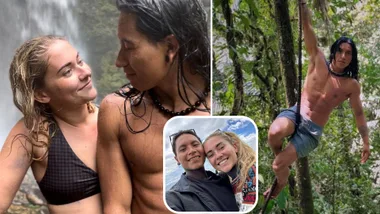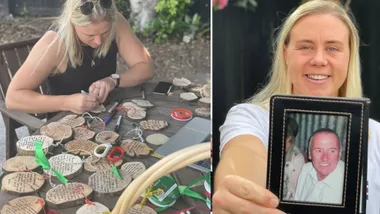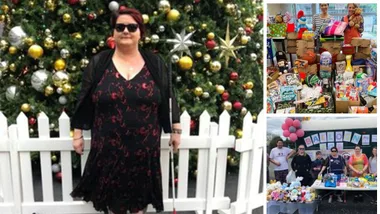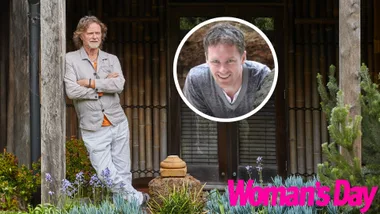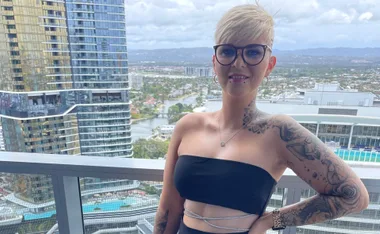Nicole McDonald, 33 shares her story of struggle and success;
I looked over at my husband Christian and we both burst out laughing.
“I still can’t believe it,” I chuckled. “We’re having twins!”
We were driving back from the hospital where I’d had a scan and we’d been given the exciting news.
We already had a son, Aza, at home and although we’d been a bit overwhelmed by the revelation at first, we were now stoked.
Later that day, Christian went to work and my phone rang.
It was a nurse from the hospital.
“We need you to come back,” she said.
I didn’t think much of it.
Twins were always going be a little complicated.
Mum gave me a lift and when the when the doctor sat me down opposite, I realised he wasn’t smiling.
“Nicole, there’s something we missed,” he began as my heart rate sped up.
“Is something wrong?” I asked.
He took a deep breath.
“Your twins are joined at the head,” he continued.

We were stoked to find out we were having twins
I stared at him in complete shock.
It was literally the last thing I’d expected him to say.
He explained it was a rare condition called craniopagus, which meant their skulls were fused together at the top of the head.
“We don’t know if they are joined at the brain,” he said.
“But you can terminate the pregnancy if you wish.”
A thousand questions swirled in my mind.
What sort of future would these babies have?
Would they have a normal childhood?
I didn’t have the answers.
The only thing certain was that I knew I couldn’t terminate.
One the way home I burst into tears.
“You’ve been given these babies for a reason,” Mum said gently and I knew she was right.
That afternoon, I looked up conjoined twins online.
Some shared limbs, others skulls.
But there were many successful separation stories too.

I knew I couldn’t terminate
Feeling more positive, I rang Christian and told him what the doctor had said.
He listened in stunned silence and then began to cry.
That set me off again too.
But I steeled my resolve.
“They can survive,” I said tearfully. “We can do this.”
In the days that followed, shock turned to determination.
Nicole, you can bring these babies into the world safely, I told myself.
More scans revealed we were having twin boys. I stared at their image on the screen and my heart filled with love.
“It’s going to be ok,” I said to Christian.
My love for them continued to grow as my belly did.
Doctors planned for me to have the babies at 38 weeks by C-section.
But with six weeks still to go, I was at home when suddenly I felt a gush between my legs.
My waters had broken.

Our beautiful newborn boys
It was too early and I was terrified of going into labour.
I grabbed the phone and called Christian.
Then I rang my grandparents to look after Aza.
At hospital I was wheeled straight into the operating theatre and I clutched Christian’s hand as the surgeon got to work.
Within minutes I heard someone say: “They’re here.”
I tried to look but they were immediately whisked off to a specially-adapted neonatal unit.
I was drowsy from all the drugs I’d been given and went to sleep.
When I woke up, Christian was by my side.
“Let’s go see them,” he smiled.
We were led to an incubator and Christian grasped my hand to steady me.
I was expecting to be confronted by what I saw but I wasn’t.
“They’re beautiful,” I gasped.
Underneath the tubes and wires were two babies.
They were joined at the top of the head but I only saw two perfect little boys.
Our boys.
They weighted 1.3kg and 1.8kg and we named them Jadon and Anias.
They stayed in hospital and over the next few months doctors focused on getting them stronger.
We were warned it would be a while before we could think about doing a separation.

Christian and me with the boys
The boys needed help from machines to eat and breathe.
I was desperate for a cuddle but could only sit beside them stroking their skin and talking and singing to them.
Once they grew stronger, I could hold them in my arms rocking them as they gazed up at me.
Scans showed their brains were connected in a complicated way so they had operations to separate their blood vessels while their skulls remained fused.
After an entire year in hospital, it was finally time.
“They’re ready,” our doctor said.
The procedure was extremely dangerous.
It would take 30 hours and they’d have their skulls rebuilt with their own bone and skin.
They’d finally be independent of each other but would also have to relearn how to do everything as if they were newborns.
As they were wheeled off into theatre I kissed them on the bit of forehead they shared.

Our family together after the surgery
“We love you boys so much,” I said.
After that, all we could do was wait.
0The surgery was so complicated there was a chance they wouldn’t survive.
And if they did, there was no guarantee they’d lead normal lives.
It was terrifying.
Hours ticked by and finally the theatre door swung open and an exhausted figure emerged.
“It wasn’t straight forward,” the surgeon sighed.
I held my breath as he explained that at one point the medical team thought they’d have to stop the procedure altogether.
“But we did it in the end.
The boys are separated,” he continued.
1
I wanted to give Anias (left) and Jadon the best start
We were so relieved but they weren’t quite out of the woods yet.
Anias needed more surgery to reduce fluid on his brain but Christian and I were allowed to visit Jadon.
It was strange seeing him for the first time without his brother.
Sadly, while he began to thrive, Anias struggled with breathing difficulties
There were a lot of tough times over the next year.
The boys had to learn how to sit up, as they’d only ever been able to lie together.

We’re just like any other family
Anias was very timid and scared of everything.
But in time, they both developed beautifully and at last we were finally able to bring the twins home.
Now, they’re three and are happy little boys.
Jadon can count to 20 and is learning to walk.
Doctors are still working with Anias but he’s doing brilliantly.
For now, we just take each day as it comes.
I once wondered what sort of life my boys would have, if we’d ever be a normal family.
My answer is no different from the one any mum would give – every moment with your kids is a gift.
3


